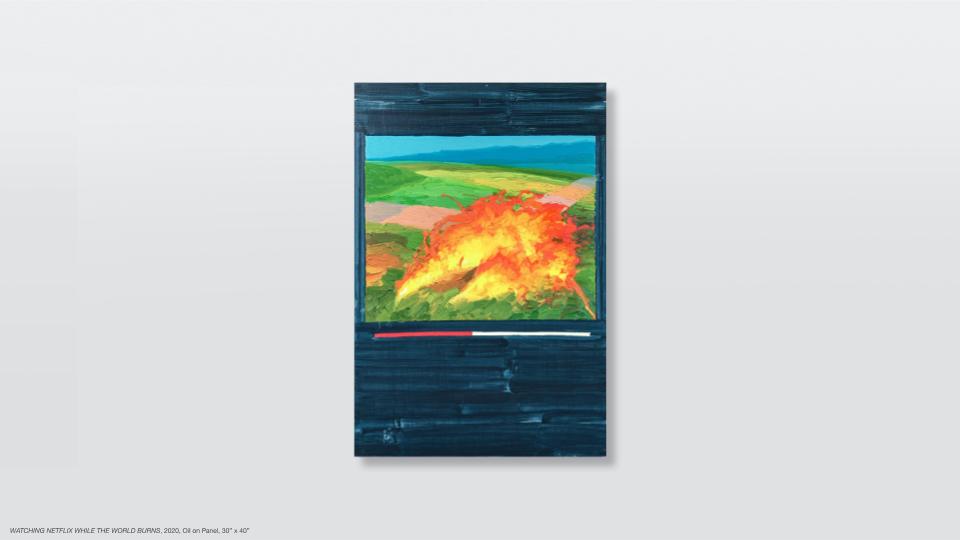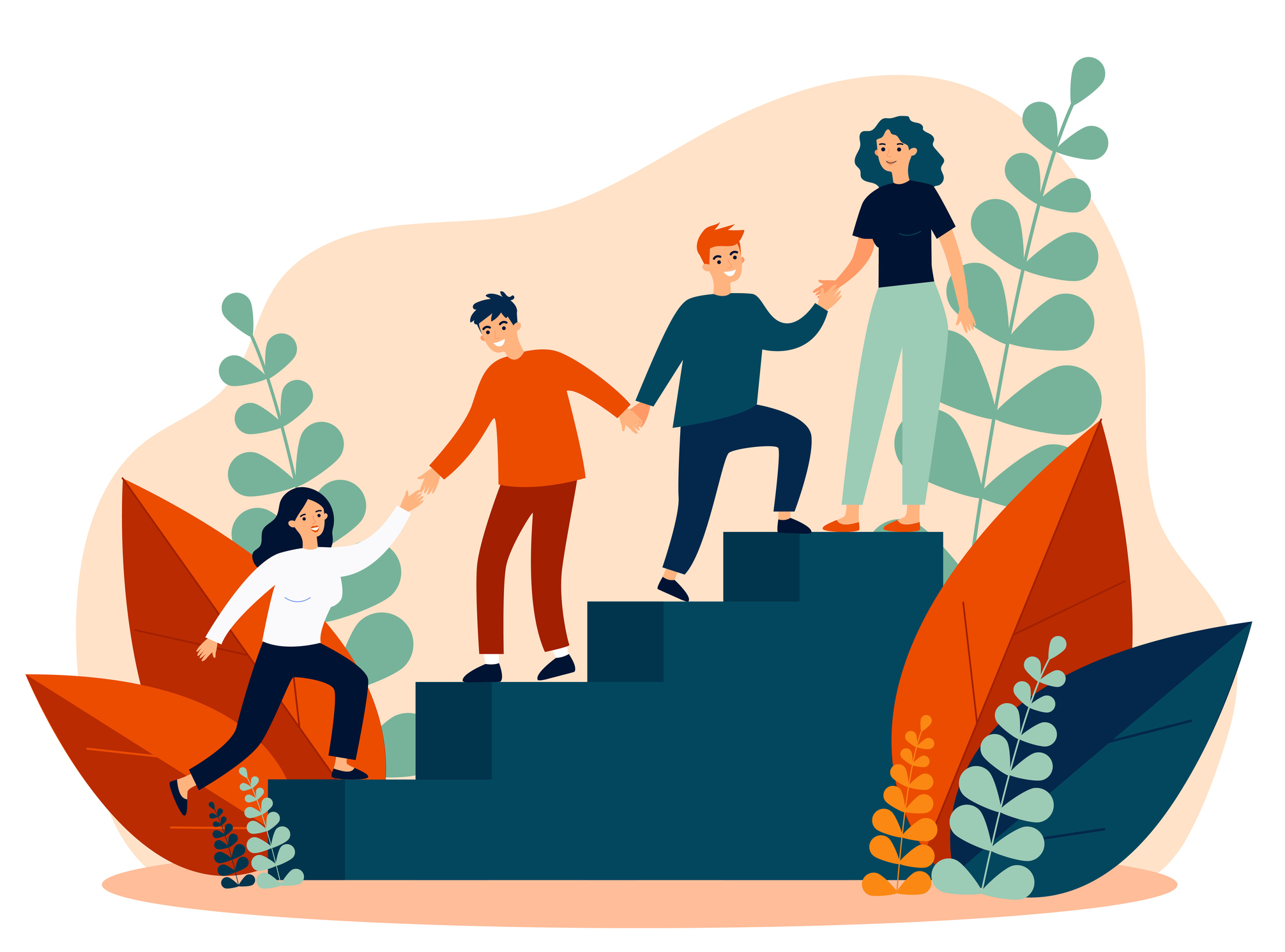As the semester comes to an end, we are pleased to share the 2025 Spring…

Zack Chomz on “Watching Netflix while the World Burns”
 Zack Chomz is a Boston-based artist who works in painting and new media. He is also one of our 2020 Walter Feldman Fellows. We are excited to share an excerpt of the conversation we had with Zack on November 24, 2020.
Zack Chomz is a Boston-based artist who works in painting and new media. He is also one of our 2020 Walter Feldman Fellows. We are excited to share an excerpt of the conversation we had with Zack on November 24, 2020.
Natalie: Could you introduce yourself?
Zack: My name is Zack Chomz. I was born in Massachusetts and am currently based in Boston. I think I’m still early in my creative journey. But it’s been three years since grad school and I think it’s becoming more clear to me now how I want to use painting and new media, what images mean to me, how they’re important to my sense of self, and how I interpret myself in the greater context of society. I don’t really identify as a “Painter” with a capital “P.” Painting has just been a really good way to condense and boil down overarching concepts and ideas into my work. But now I think these ideas are ready to transcend the painted surface and start to come into play with different objects, materials, and contexts.
Natalie: What are you currently trying to explore?
Zack: Material-wise, I’ve been really focused, on creating some sort of antagonism between new media and traditional media that makes it so present when the viewer is standing in that space. The difference becomes so apparent that it would force you to consider your own location within that. Subject wise, I’ve always been trying to find a way to get people to have a conversation about proximity – what it means to be close to something, an event, or the world, and removal. That boils down to – what does it mean to witness an age where entertainment, technology, and tragedy are so entwined? I don’t really have a singular artist statement. I’m almost resistant to that.
Zack showed us the series of works he’s been working on. The title of the series is “Watching Netflix while the World Burns”.
Natalie: What does this title mean?
Zack: Right now, this is just a working title, so it’s still liable to be changed. Being from the suburbs I was generally removed from focal points and major events in the world. I discovered over time that there’s a privilege to being able to escape from the world in the luxuries of having a backyard so you can hide away without confronting the world. And the more I grew, I realized the only way that I’m seeing is through phone screens, laptop screens, which everyone is talking about now. This title isn’t a comment on coronavirus, but instead about the fact that we consume information and entertainment in the same locations. The world around us might feel like it’s on fire, or it really is on fire, or a mix of both. We might open up our screens and see all these major incidents but instead of checking in on what’s happening, we decide to watch The Great British Baking Show. Nihilism is a certain half of the pendulum, a willingness to disregard the concerns of the world via indulgence in media and entertainment. But I think it’s important that there are two sides. I don’t want to make specific declarations in the work. I don’t want to say if you’re watching Netflix, you’re ignoring the world. Because you can actually turn on Netflix and discover something about the world that illuminated you or be exposed to something new that you didn’t know about that you should know about. There’s this consistent play throughout the works of either being exposed to media translation or hiding away willfully.

Natalie: Tell us about this painting. It has the same name as the title of your series.
Zack: This painting happened before the title and it happened over the course of two years. It’s the nature of how I work – I will jot down the paintings in my sketchbook, and they will often get tucked away for a long time until I pull it out. I started this painting at the end of 2018 and I pulled it back out in 2020. It suddenly felt a lot more relevant with the entire world changing. It’s meant to be a cartoon, and the loading bar implies that I’ve been witnessing this through a screen instead of the real world. This led me to make sure that any of the imagery in my works that seem to be removed from my immediate surroundings is isolated and presented as such.

Natalie: Could you talk about these works?
Zack: The painting on the left is called “IG SCROLL”. You know how the Instagram algorithm puts together all the things that it thinks I want to see. This is like a fingerprint, but also a self-portrait of myself. There’s a certain self-criticism here. I really believe that if I’m going to have a criticism of the world, I’ll have to also be on the table for criticism. I think that the artist has to be towards the front of the investigation in terms of, how am I playing into the things that I’m trying to shed light on. I think it’s hard to be taken seriously if you’re not at least acknowledging that you are part and parcel of that scenario. I can’t presume to know how to fix every moral issue, but it’s important to isolate myself as a component of the critique. You just have to acknowledge it. And I think that’s what this painting is. And next to the painting, I’m playing with the 3D printer and I’m understanding that the printer actually provides something that the painting can’t, which is that the printer negates the human touch. It’s a series of 1’s and 0’s. It will only print what the information is. There’s no room for interpretation. So, it kind of ghosts and removes the leftovers of my hand. One of the things that makes the painting on the left so perverse is that I’m painting the butt, the snake, and the explosion physically, involving a certain level of engagement on my part. But the 3D printer just strips that away and creates, basically, a ghost.

Natalie: Let’s move on to “Rhododendron Curtains”.
Zack: If we’re thinking, conceptually, about a hideaway space and never having to face the world, one of the devices or characters that I have extracted is the rhododendron bush. Growing up in New England, the rhododendrons are everywhere in the suburbs. I specifically remember moments of neighbors and people planting rhododendron bushes so that they’ll grow massive to block the view of people looking into their space and them looking into others’ space. I wanted to create this flat repetition, this wall of rhododendron that you couldn’t see through. There’s something odd or scary about taking natural forms and running them through the 3D printer and looking at what happens when it comes out. It’s really a tombstone or a preserved, fossilized version of it but digital.
Natalie: What are your plans for the future?
Zack: The original plan was to have an exhibition through the Walter Feldman Fellowship, but I skipped and decided just to keep diving into making more work. I’m not interested right now in putting together an exhibition that I don’t think even my grandparents can come to see. It’s been 6 or 7 years of just grinding, missing things, canceling on friends just to get this done. I’m hoping by 2021 or 2022 I’ll be able to show the works in a space, so there can be an opportunity for dialogue to happen in person with the objects, and so people in the community, as well as my former students can come to see.
Natalie: What role has the Feldman Fellowship played in your professional development?
Zack: It’s been a great experience. It’s helping me push my work to the next level from making works that people make in school, and then being fresh out and figuring which direction to go. It led me to start exploring some new media projects using the 3D printer. Together with Almitra, we’ve been building a website, plotting and planning grants and opportunities, preparing statements, having critical conversations about how the work should be presented, in what matter, and how it’s described. Those are all very invaluable. I’ve also been able to sit on several seminars that are linked with the Creative Entrepreneur Fellowship which have been extremely helpful, including financial advice, taxes, keeping records, and navigating media. Before COVID hit, Almitra and I were also talking about putting together an exhibition. It’s always great to have someone check on you, go into these conversations with you in a serious way, and be taken seriously. All of these have been really helpful this year.
Natalie: Do you have any recommendations for artists considering applying to the Fellowship?
Zack: If you are an emerging artist and you feel ready to go through the work of putting together your professional presence, and you are ready to start expanding upon your ability to seek and land opportunities, then I think the Walter Feldman program is a great way to begin. This fellowship will help you to assemble the necessary assets and will provide critical feedback throughout the process. Overall, the sense of community is the best aspect of this fellowship – and that’s something extremely valuable to an artist. I think if you’re ready for that, and you’re ready to work, then apply for this fellowship.


